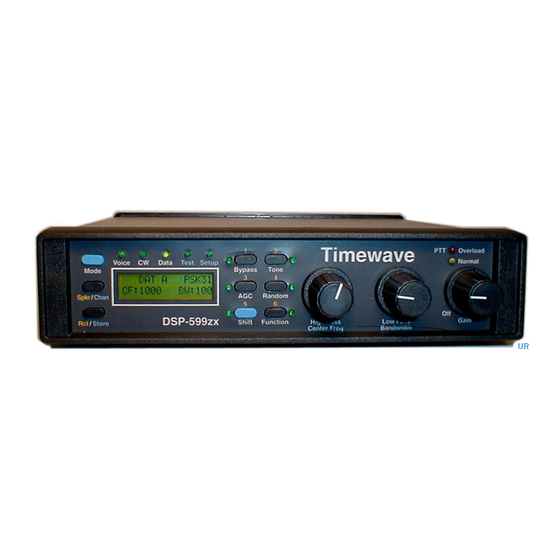Advertisement
Quick Links
Timewave DSP-599zx Operation Reference Card
All Modes
Feature
Change Primary
Press [Mode]
Operating Mode
(Voice, CW, Data)
Select Test or Setup
Press [Shift+Mode]
modes
Cancel [Shift] action
Press [Shift] or wait three seconds
Turn speaker on/off.
Press [Spkr/Chan]
Change channels
Press [Shift+Spkr/Chan]
Store a setting in
Press [Shift+Rcl/Store+{#}]
memory
# = memory number (1 - 6)
Recall a stored setting
Press [Rcl/Store+{#}]
# = memory number (1 - 6)
Restore previous
Press [Rcl/Store+Rcl/Store]
setting
Change power-up
Press [Shift+Rcl/Store+Mode]
mode
Bypass all settings
Press [Bypass]
Turn AGC on/off
Press [AGC]
Enable random noise
Press [Random]
reduction
Voice Mode
Feature
Adjust high pass filter
Turn left knob [High Pass]
Adjust low pass filter
Turn middle knob
[Low Pass]
Enable random noise
Press [Random]
reduction
Adjust aggressiveness
Press [Shift+Random], turn left knob to
of noise reduction
adjust. Press left knob to accept.
Turn AM line noise
Press [Function]. LED illuminated
filter on/off
indicates on.
Eliminate heterodyne
Press [Tone]. LED illuminated indicates
tones
on.
Turn on/adjust notch
Press [Shift+Tone]. Turn left knob
filter
[Center Freq] to change Notch Center
Frequency. Rotate middle knob to adjust
Notch Bandwidth. Accept by pressing left
knob.
Turn off notch filter
Press [Shift+Tone] or press middle knob.
Change freq of AM
Press [Shift+Mode] twice. Turn left knob
line noise filter
until Voice appears. Press left knob to
accept. Turn left knob until AM Line Noise
appears. Press left knob to accept. Turn
left knob until desired value is viewed.
Press left knob to accept, press middle
knob to cancel and escape.
Required Actions
Required Actions
Description/Notes
Each time [Mode] is press, the DSP-599zx the operating mode changes to
the next mode.
Press [Shift+Mode] once for Test mode and twice for Setup mode.
Pressing [Shift] twice in a row with no other button pressed cancels [Shift].
By waiting three second without any other action, [Shift] will time out.
Pressing [Spkr/Chan] toggles the speaker on and off.
Pressing [Shift+Spkr/Chan] toggles between channels.
Stores a common operating configuration to memory for easy recall. Stores
every setting except audio gain control position. Six memories available.
Recalls a common operating configuration from memory. Recalls all settings
except audio gain control position. Six memories available.
Recalls previous setting before the memory recall. Allows quick toggling
between two operating settings.
Stores the operating mode and channel that you wish to power up with. Can
be changed at any time by repeating process.
Actual operation varies with mode of operation. Generally routes signal past
all signal processing.
Optimizes signal levels for best filter performance and enhances listening by
minimizing audible signal level variation.
An adaptive multi-tone filter that can remove multiple tones simultaneously.
Removes multiple heterodynes almost completely.
Description/Notes
By turning the left knob, you can adjust the high pass filter from 100 Hz to
1000 Hz
By turning the middle knob, you can adjust the low pass filter from 1000 Hz
to 5000 Hz
Can be very effective in reducing offending background noise.
The aggressiveness can be adjusted from one to nine with default value of
five. The higher the value, the greater the noise reduction.
This does not work on SSB signals. It is designed primarily for AM signals.
The automatic filter can virtually eliminate multiple heterodynes and reduce
CW and FSK data signals.
Rotate left knob until unwanted signal disappears. Rotate middle knob to
adjust width of filter. The lower the value the narrower the filter. Filter
widths 1 - 5 are single notch filters. Filter widths 6 - 9 are dual notch filters
for data signals. As a reminder, a or will be displayed.
Removes notch filter after it is no longer needed.
You can select between 50 and 60 cycles. Your choice will depend upon the
frequency of the local AC electrical power.
Advertisement

Subscribe to Our Youtube Channel
Summary of Contents for Timewave DSP-599zx
- Page 1 All Modes Feature Required Actions Description/Notes Change Primary Press [Mode] Each time [Mode] is press, the DSP-599zx the operating mode changes to Operating Mode the next mode. (Voice, CW, Data) Select Test or Setup Press [Shift+Mode] Press [Shift+Mode] once for Test mode and twice for Setup mode.
- Page 2 Hz. Baud rate is determined by RTTY parameter settings. If baud rate is 100 baud or higher, no tone is enabled. RTTY Modem Always on in RTTY operation See Section 2 of DSP-599zx Operating Manual for proper connection information. RTTY Remodulator Press [Function] in RTTY operation Sends regenerated RTTY signal to line output.



Need help?
Do you have a question about the DSP-599zx and is the answer not in the manual?
Questions and answers